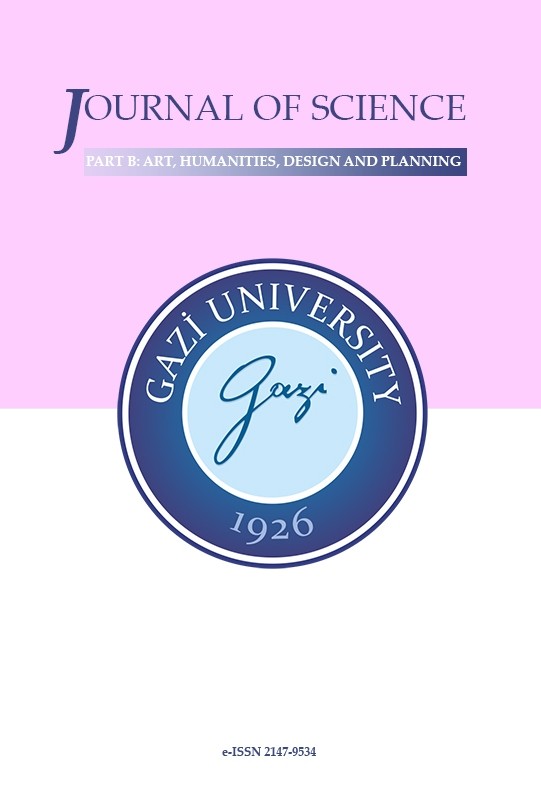Analysis of Space in Architecture: A Perspective on Subject-Meaning Relationship
Analysis of Space in Architecture: A Perspective on Subject-Meaning Relationship
___
- [1] Merleau-Ponty, M. (2017). Algının Fenomenolojisi. (Çev.: Emine Sarıkartal, Eylem Hacımuratoğlu). İthaki Yayınları.
- [2] Cevizci, A. (1999). Felsefe Sözlüğü. Paradigma Yayınları. s.328
- [3] Heidegger, M. (2013). Hümanizm Üzerine, (Çev.: Yusuf Örnek). Felsefe Kurumu Yayınları. s.42
- [4] Heidegger, M. (2008). Varlık ve Zaman. (Çev.: Kaan H. Ökten). Agora Kitaplığı. s.152
- [5] Goodman, N. (1985). How Buildings Mean. Critical Inquiry. Vol.11. No.4. The University of Chicago Press. p.642-654
- [6] Capdevila-Werning, R. (2014). Goodman for Architects, Thinkers for Architects 10. Routledge. p.3
- [7] Aydınlı, S. (2000). Epistemolojik Açıdan Mekan Yorumu, Mimarlık ve Felsefe, (Yay. haz.: A. Şentürer, Ş. Ural, ve A. Atasoy). YEM Yayın. s.41-42-50
- [8] Rifat, M. (2011). Homo Semioticus ve Genel Göstergebilim Sorunları. Yapı Kredi Yayınları. s.17-31
- [9] Schopenhauer, A. (2009). İsteme ve Tasarım Olarak Dünya. (Çev.: Levent Özşar). Biblos Yayınevi, s.10-17
- [10] Gürsoy, K. (2007). Maurice Merleau-Ponty’de Algı Problemine Giriş. Lotus Yayın. s.38-39
- [11] Merleau-Ponty, M. (2002). Phenomenology of Perception. (Trans.: Colin Smith). Routledge London. p.79
- [12] Nietzsche, F. (2010). Güç İstenci- 485/ Bahar-Güz 1887. (Çev.: Nilüfer Epçeli). Say Yayınları. s.367-368
- [13] Descartes, R. (1942). İlk Felsefe Üzerine Metafizik Düşünceler. (Çev.: Mehmet Karacan). Fransız Klasikleri 11. Maarif Matbaası. s.112
- [14] Hegel, G.W. F. (1986). Tinin Görününgübilimi. (Çev.: Aziz Yardımlı). İdea Yayınları. s.462
- [15] Kant, I., Schopenhauer, A. & Heidegger, M. (2009). Düşüncenin Çağrısı. (Çev.: Ahmet Aydoğan). Say Yayıncılık. s. 69-71
- [16] Heidegger, M. (2001). Nietzsche’nin Tanrı Öldü Sözü ve Dünya Resimleri Çağı. (Çev.: Levent Özşar). Asa Kitabevi. s.78-79
- [17] Forty, A. (2000). Words and Buildings - A Vocabulary of Modern Architecture. London: Thames& Hudsons. p.256-266
- [18] Smith, A., D. (2013). Algının Teni: Merlau-ponty ve Husserl. (Çev.: Sercan Öztekin). 17(51). Fesatoder Yayınları. s.44-45
- [19] Eliade, M. (1991). Kutsal ve Dindışı. (Çev.: Mehmet Ali Kılıçbay). Gece Yayınları. s.5
- [20] Goodman, N. (1988). Ways of Worldmaking. Fifth Publishing. Hackett Publishing Company. p.6
- [21] Bachelard, G. (2012). Düşlemenin Poetikası. (Çev.: Alp Tümertekin). İthaki Yayın. s.15
- [22] Fisher, G. (2015). Mimarlık ve Dil. (Çev.: Fatma Erkman Akerson). Daimon Yayınları. s.52-53
- [23] Bilen, O. (2016). Çağdaş Yorumbilim Kuramları. Doğu Batı Yayınları. s.66-67
- [24] Boudon, P. (2015). Mimari Mekân Üzerine. (Çev.: Alp Tümertekin). Janus Yayın. s.10-11
- [25] Bakhtin, M. (2000). Karnavaldan Romana. (Çev.: Cem Soydemir). Ayrıntı Yayın. s.20
- [26] Aktulum, K. (2000). Metinlerarası İlişkiler. Öteki Yayınevi. p.20
- [27] Grabar,O. (2018). İslâm Sanatının Oluşumu. (Çev.: Nuran Yavuz). Alfa Yayıncılık. s.143-249
- [28] Fazlıoğlu, İ. (2015). Kendini Bulmak. Papersense Yayınları. s.46
- Yayın Aralığı: Yılda 4 Sayı
- Başlangıç: 2013
- Yayıncı: Gazi Üniversitesi
Typological analysis of wooden minaret mosques in Tokat.
Elif YAPRAK BAŞARAN, Özlem SAĞIROĞLU DEMİRCİ
Considering Industrial Design In The Context Of Communication: The Concept of Design Communication
Urban Morphology Schools: A Review of the English, Italian, and French Schools of Thought
Lost Tangible Cultural Heritage: A Traditional Tokat House Restoration Project
User - Space Relationship in Emergency Departments
A competition story: Nazım Hikmet Cultural Center
Neslihan DEVRAN, Fatih Çağrı AKÇAY
EN-SUITE BATHROOM ANALYSIS IN A TRADITIONAL TURKISH HOUSE: YALVAÇ HOUSE AND GUSÜLHANE
Nuriye Hande KUTBAY, Cemil YAVUZ
ASSESSMENT OF BUILDINGS IN DIFFERENT ERAS OF RIFAT CHADIRJI
Melek KUTLU DİVLELİ, Norwina MOHD NAWAWI, Aida Kesuma AZMIN
Ayorinde OLUYEMİ, Oluwafemi ADELABU, Professor E.b. Oladumiye OLADUMİYE
Evaluation of the Accessibility of the Disabled in Urban Areas on the Sample of the National Library
